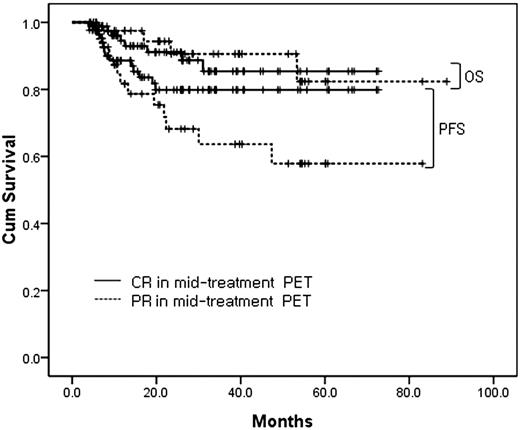Abstract
Abstract 3949
Poster Board III-885
Mid-treatment positron emission tomography (PET) has been found to predict clinical outcomes in patients with aggressive non-Hodgkin's lymphoma. Currently, risk-adapted therapy based on mid-treatment PET has been widely evaluated. This study was intended to assess the prognostic value of mid-treatment PET in patients who achieved metabolic complete response (mCR) at post-treatment PET.
From February 2002 to March 2009, total 130 patients in whom post-treatment PET showed mCR were included in this study. We performed retrospective analysis of progression-free survival (PFS) and overall survival (OS) according to the results of mid-treatment PET.
Median age (range) was 51 (16-85) years old, and 70 (54%) patients were male. International Prognostic Index (IPI) was low (0-2) in 91 (70%) patients and high (3-5) in 39 (30%) patients. As a front-line chemotherapy, most frequently administered regimen was R-CHOP (76%). Eighty-seven (67%) patients were mCR, and 43 (33%) patients were metabolic partial response (mPR) in mid-treatment PET. With 24 months of median follow-up, 3 year-rates of PFS and OS in overall patients were 74% and 87%, respectively. Differences of survival outcomes between patients with mCR and mPR at mid-treatment PET were not statistically significant in terms of PFS (p=0.13) and OS (p=0.76).
In patients with metabolic CR at post-treatment PET, survival outcome was not influenced by the results of mid-treatment PET. Therefore, risk-adapted therapy solely based on mid-treatment PET might be inappropriate in the management of newly diagnosed DLBCL.
No relevant conflicts of interest to declare.
Author notes
Asterisk with author names denotes non-ASH members.


